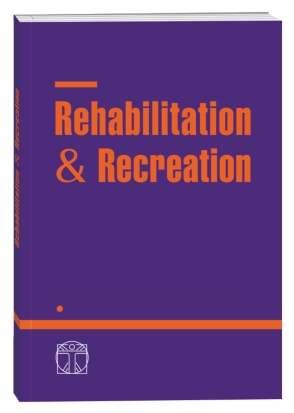PROBLEMS OF PHYSICAL THERAPY OF MOVEMENT DISORDERS WITH INSTABILITY OF THE SHOULDER JOINT
DOI:
https://doi.org/10.32782/2522-1795.2022.13.2Keywords:
instability of the shoulder joint, dislocation, disability, physical therapy, rehabilitation.Abstract
Objective. Evaluation of world experience in the rehabilitation of movement disorders in patients with shoulder joint instability and development of the most prospective tasks in physical therapy. Material. To achieve set objective, an analysis of literature sources in modern databases was conducted: Google Scholar, PubMed, Cochrane Central Register of Controlled Trials. The depth of the search is 10 years (from January 2013 to November 2022). Results. Dislocation of the shoulder joint is a common pathology, and recurrent instability of the shoulder joint is a severe complication of dislocation, characterized by partial disability and a significant decrease in quality of life. There is a wide range of diagnostic methods that allow to determine the nature of instability. However, the issue of functional diagnosis remains open. Taking into consideration the presence of single studies on the determination of muscle thickness using ultrasound examination as a sign of muscle function, it is proposed to use this method to develop a differentiated physical rehabilitation program. Despite significant advances in surgical treatment, the relapse rate continues to be high. There are no high-quality researches examining the impact of rehabilitation on functional and long-term results. Although the role of postoperative rehabilitation is crucial to achieving normal range of motion and an adequate return to activity, very often rehabilitation programs are poorly described or not described at all in shoulder instability treatment protocols. Also, there are significant differences in rehabilitation programs, the timing of their start and the duration of exercises. Conclusions. Taking into account the widespread occurrence of the considered pathology, its significant impact on the quality of life and performance of patients, the development and implementation of an effective rehabilitation program in health care practice is important.
References
Imam MA, Shehata MSA, Martin A, Attia H, Sinokrot M, Bahbah EI, Gwilym S, Jacob J, Narvani AA, Meyer DC. Bankart Repair Versus Latarjet Procedure for Recurrent Anterior Shoulder Instability: A Systematic Review and Meta-analysis of 3275 Shoulders. Am J Sports Med. 2021 Jun;49(7):1945-1953. doi: 10.1177/0363546520962082.
Shields DW, Jefferies JG, Brooksbank AJ, Millar N, Jenkins PJ. Epidemiology of glenohumeral dislocation and subsequent instability in an urban population. J Shoulder Elbow Surg. 2018 Feb;27(2):189-195. doi: 10.1016/j.jse.2017.09.006.
Козопас В. С. Діагностика хронічної реци- дивуючої нестабільності плечового суглоба // Науковий журнал# 29 квітень 2021. 2021. С. 36.
Olds MK, Ellis R, Parmar P, Kersten P. Who will redislocate his/her shoulder? Predicting recurrent instability following a first traumatic anterior shoulder dislocation. BMJ Open Sport Exerc Med. 2019 Mar 7;5(1):e000447. doi: 10.1136/bmjsem-2018-000447.
Chang LR, Anand P, Varacallo M. Anatomy, Shoulder and Upper Limb, Glenohumeral Joint. 2022 Aug 8. In: StatPearls [Internet].
Lahti A, Andernord D, Karlsson J, Samuelsson K. ABC om – Axelluxation [Shoulder dislocation]. Lakartidningen. 2016 Sep 27;113:DXD4. Swedish.
Tuite MJ, Pfirrmann CWA. Shoulder: Instability. 2021 Apr 13. In: Hodler J, Kubik-Huch RA, von Schulthess GK, editors. Musculoskeletal Diseases 2021-2024: Diagnostic Imaging [Internet]. Cham (CH): Springer; 2021. Chapter 1. Available from: https://www.ncbi.nlm.nih.gov/books/ NBK570161/ doi: 10.1007/978-3-030-71281-5_1.
Friedman LGM, Lafosse L, Garrigues GE. Global Perspectives on Management of Shoulder Instability: Decision Making and Treatment. Orthop Clin North Am. 2020 Apr;51(2):241-258. doi: 10.1016/j.ocl.2019.11.008.
Путьонний Ф., Попадюха Ю. Фізична реабілітація при нестабільності плечового суглоба. Теорія і методика фізичного вихо- вання і спорту. 2017. № 2. С. 68–70.
Hawkes DH, Khaiyat OA, Howard AJ, Kemp GJ, Frostick SP. Patterns of muscle coordination during dynamic glenohumeral joint elevation: An EMG study. PLoS One. 2019 Feb 8;14(2):e0211800. doi: 10.1371/journal. pone.0211800.
Moroder P, Danzinger V, Maziak N, Plachel F, Pauly S, Scheibel M, Minkus M. Characteristics of functional shoulder instability. J Shoulder Elbow Surg. 2020 Jan;29(1):68-78. doi: 10.1016/j.jse.2019.05.025.
Goetti P, Denard PJ, Collin P, Ibrahim M, Hoffmeyer P, Lädermann A. Shoulder biomechanics in normal and selected pathological conditions. EFORT Open Rev. 2020 Sep 10;5(8):508-518. doi: 10.1302/2058-5241.5.200006.
Moya D, Aydin N, Yamamoto N, Simone JP, Robles PP, Tytherleigh-Strong G, Gobbato B, Kholinne E, Jeon IH. Current concepts in anterior glenohumeral instability: diagnosis and treatment. SICOT J. 2021;7:48. doi: 10.1051/sicotj/2021048.
Dickens JF, Owens BD, Cameron KL, Kilcoyne K, Allred CD, Svoboda SJ, Sullivan R, Tokish JM, Peck KY, Rue JP. Return to play and recurrent instability after in-season anterior shoulder instability: a prospective multicenter study. Am J Sports Med. 2014 Dec;42(12):2842-50. doi: 10.1177/0363546514553181.
Levy BJ, Grimm NL, Arciero RA. When to Abandon the Arthroscopic Bankart Repair: A Systematic Review. Sports Health. 2020 Sep/Oct;12(5):425-430. doi: 10.1177/1941738120940676.
Zhang M, Liu J, Jia Y, Zhang G, Zhou J, Wu D, Jiang J, Yun X. Risk factors for recurrence after Bankart repair: a systematic review and meta-analysis. J Orthop Surg Res. 2022 Feb 20;17(1):113. doi: 10.1186/ s13018-022-03011-w.
Barlow JD, Grosel T, Higgins J, Everhart JS, Magnussen RA. Surgical treatment outcomes after primary vs recurrent anterior shoulder instability. J Clin Orthop Trauma. 2019 Mar-Apr;10(2):222-230. doi: 10.1016/j. jcot.2018.10.012.
Beletsky A, Cancienne JM, Manderle BJ, Mehta N, Wilk KE, Verma NN. A Comparison of Physical Therapy Protocols Between Open Latarjet Coracoid Transfer and Arthroscopic Bankart Repair. Sports Health. 2020 Mar/Apr;12(2):124-131. doi: 10.1177/1941738119887396
Eshoj H, Rasmussen S, Frich LH, Hvass I, Christensen R, Jensen SL, Søndergaard J, Søgaard K, Juul-Kristensen B. A neuromuscular exercise programme versus standard care for patients with traumatic anterior shoulder instability: study protocol for a randomised controlled trial (the SINEX study). Trials. 2017 Feb 28;18(1):90. doi: 10.1186/s13063-017-1830-x.
Koppenhaver S, Harris D, Harris A, O'Connor E, Dummar M, Croy T, Walker M, Flynn T. The reliability of rehabilitative ultrasound imaging in the measurement of infraspinatus muscle function in the symptomatic and asymptomatic shoulders of patients with unilateral shoulder impingement syndrome. Int J Sports Phys Ther. 2015 Apr;10(2):128-35.
Kretić D, Turk T, Rotim T, Šarić G. Reliability of Ultrasound Measurement of Muscle Thickness in Patients with Supraspinatus Tendon Pathology. Acta Clin Croat. 2018 Jun;57(2):335-341. doi: 10.20471/ acc.2018.57.02.15.
Fanning E, Maher N, Cools A, Falvey EC. Outcome Measures After Shoulder Stabilization in the Athletic Population: A Systematic Review of Clinical and Patient- Reported Metrics. Orthop J Sports Med. 2020 Sep 16;8(9):2325967120950040. doi: 10.1177/2325967120950040.
Jaggi A, Alexander S. Rehabilitation for Shoulder Instability – Current Approaches. Open Orthop J. 2017 Aug 31;11:957-971. doi: 10.2174/1874325001711010957.
Booker S, Alfahad N, Scott M, Gooding B, Wallace WA. Use of scoring systems for assessing and reporting the outcome results from shoulder surgery and arthroplasty. World J Orthop. 2015 Mar 18;6(2):244-51. doi: 10.5312/ wjo.v6.i2.244.
Downloads
Published
How to Cite
Issue
Section
License

This work is licensed under a Creative Commons Attribution-NonCommercial-NoDerivatives 4.0 International License.












